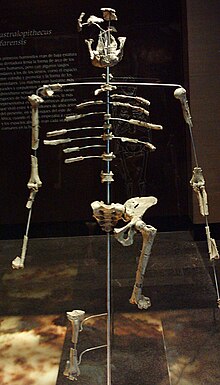Australopithecus afarensis
|
Australopithecus afarensis Temporal range: Pliocene, 3.9–2.9 Ma |
|
|---|---|
 |
|
| A replica of the remains of Lucy, Museo Nacional de Antropología, Mexico City | |
| Scientific classification | |
| Kingdom: | Animalia |
| Phylum: | Chordata |
| Class: | Mammalia |
| Order: | Primates |
| Suborder: | Haplorhini |
| Family: | Hominidae |
| Subtribe: | Australopithecina |
| Genus: | †Australopithecus |
| Species: | †A. afarensis |
| Binomial name | |
|
Australopithecus afarensis Johanson & White, 1978 |
|
Australopithecus afarensis (Latin: "Southern ape from Afar") is an extinct hominin that lived between 3.9 and 2.9 million years ago.A. afarensis was slenderly built, like the younger Australopithecus africanus. A. afarensis is thought to be more closely related to the genus Homo (which includes the modern human species Homo sapiens), whether as a direct ancestor or a close relative of an unknown ancestor, than any other known primate from the same time. Some researchers include A. afarensis in the genus Praeanthropus.
The most famous fossil is the partial skeleton named Lucy (3.2 million years old) found by Donald Johanson and colleagues, who, in celebration of their find, repeatedly played the Beatles song Lucy in the Sky with Diamonds.
Australopithecus afarensis fossils have only been discovered within Eastern Africa. Despite Laetoli being the type locality for A. afarensis, the most extensive remains assigned to the species are found in Hadar, Afar Region of Ethiopia, including the above-mentioned "Lucy" partial skeleton and the "First Family" found at the AL 333 locality. Other localities bearing A. afarensis remains include Omo, Maka, Fejej, and Belohdelie in Ethiopia, and Koobi Fora and Lothagam in Kenya.
Compared to the modern and extinct great apes, A. afarensis has reduced canines and molars, although they are still relatively larger than in modern humans. A. afarensis also has a relatively small brain size (about 380–430 cm3) and a face (i.e. a face with forward-projecting jaws).
...
Wikipedia
